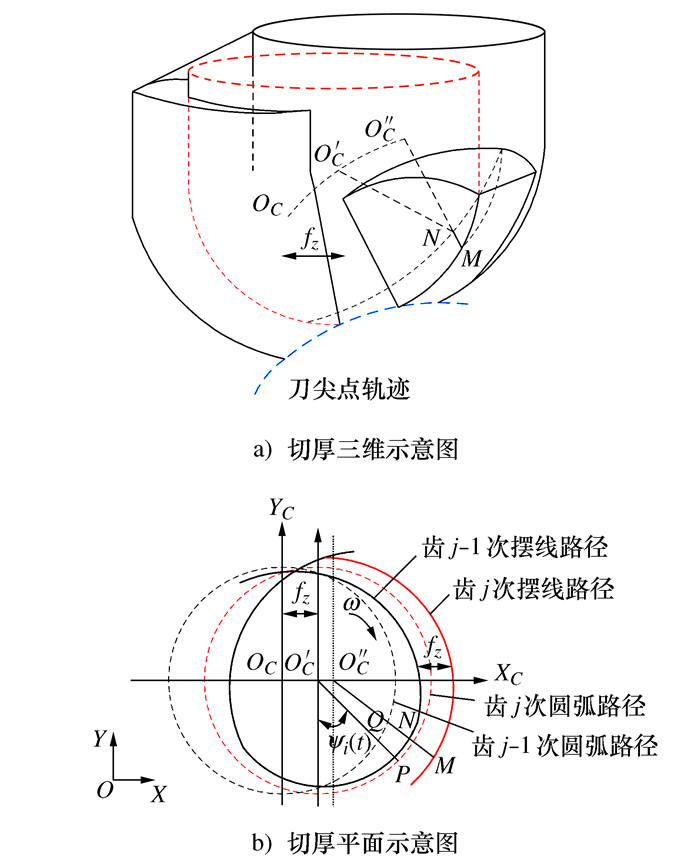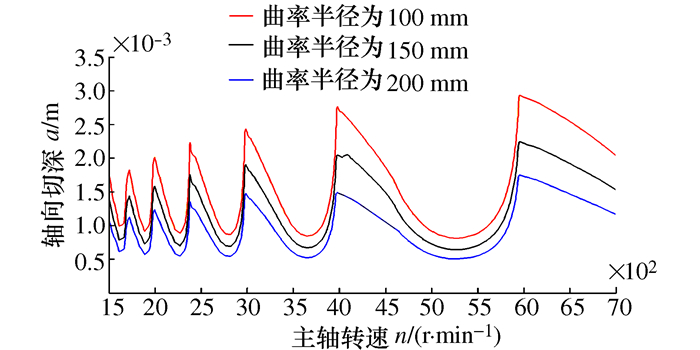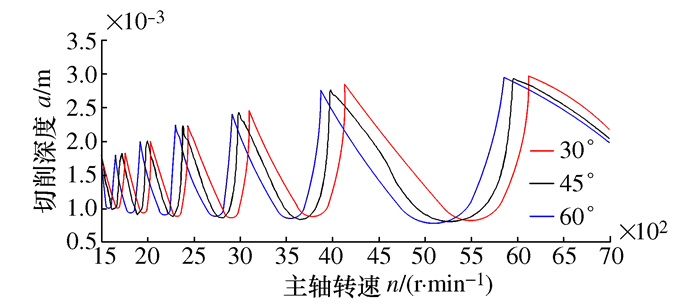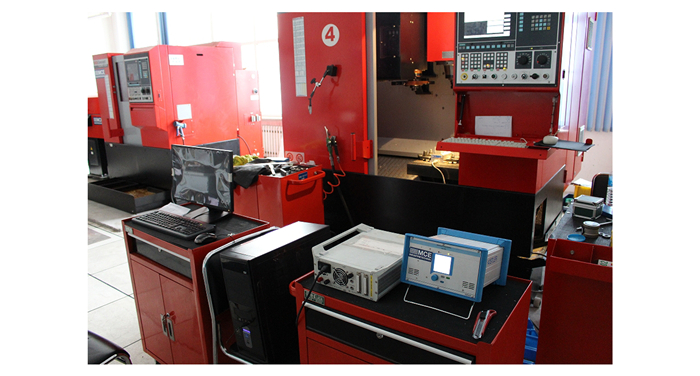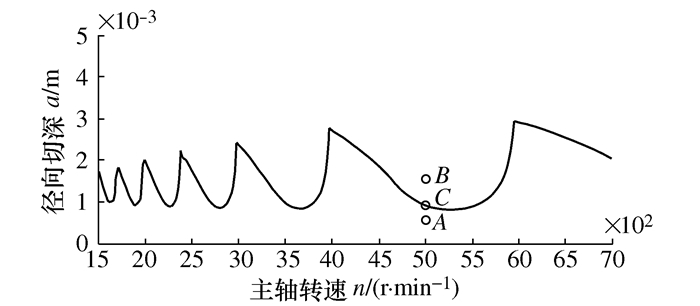|
[1]
|
Li Z Q, Liu Q. Solution and analysis of chatter stability for end milling in the time-domain[J]. Chinese Journal of Aeronautics, 2008, 21(2):169-178 doi: 10.1016/S1000-9361(08)60022-9
|
|
[2]
|
Cao H R, Li B, He Z J. Chatter stability of milling with speed-varying dynamics of spindles[J]. International Journal of Machine Tools and Manufacture, 2012, 52(1):50-58 doi: 10.1016/j.ijmachtools.2011.09.004
|
|
[3]
|
Ko J H. Time domain prediction of milling stability according to cross edge radiuses and flank edge profiles[J]. International Journal of Machine Tools and Manufacture, 2015, 89:74-85 doi: 10.1016/j.ijmachtools.2014.11.004
|
|
[4]
|
Jin X, Sun Y W, Guo Q, et al. 3D stability lobe considering the helix angle effect in thin-wall milling[J]. The International Journal of Advanced Manufacturing Technology, 2016, 82(9-12):2123-2136 doi: 10.1007/s00170-015-7570-8
|
|
[5]
|
Mousseigne M, Landon Y, Seguy S, et al. Predicting the dynamic behaviour of torus milling tools when climb milling using the stability lobes theory[J]. International Journal of Machine Tools and Manufacture, 2013, 65:47-57 http://www.wanfangdata.com.cn/details/detail.do?_type=perio&id=0e2ab86294442bbce4b6709490b0bbaf
|
|
[6]
|
Sun C, Altintas Y. Chatter free tool orientations in 5-axis ball-end milling[J]. International Journal of Machine Tools and Manufacture, 2016, 106:89-97 doi: 10.1016/j.ijmachtools.2016.04.007
|
|
[7]
|
Zhang X, Zhang J, Pang B, et al. An efficient approach for milling dynamics modeling and analysis with varying time delay and cutter runout effect[J]. The International Journal of Advanced Manufacturing Technology, 2016, 87(9-12):3373-3388, doi: 10.1007/s00170-016-8671-8
|
|
[8]
|
Seguy S, Insperger T, Arnaud L, et al. Suppression of period doubling chatter in high-speed milling by spindle speed variation[J]. Machining Science and Technology, 2011, 15(2):153-171 doi: 10.1080/10910344.2011.579796
|
|
[9]
|
Ozoegwu C G, Omenyi S N, Ofochebe S M. Hyper-third order full-discretization methods in milling stability prediction[J]. International Journal of Machine Tools and Manufacture, 2015, 92:1-9 doi: 10.1016/j.ijmachtools.2015.02.007
|
|
[10]
|
Wang S B, Geng L, Zhang Y F, et al. Chatter-free cutter postures in five-axis machining[J]. Proceedings of the Institution of Mechanical Engineers, Part B:Journal of Engineering Manufacture, 2016, 230(8):1428-1439, doi: 10.1177/0954405415615761
|
|
[11]
|
Ahmadi K, Ismail F. Analytical stability lobes including nonlinear process damping effect on machining chatter[J]. International Journal of Machine Tools and Manufacture, 2011, 51(4):296-308 doi: 10.1016/j.ijmachtools.2010.12.008
|
|
[12]
|
李勤良, 汪博, 赵斌, 等.考虑非线性迟滞力的机床颤振系统稳定性研究[J].机械工程学报, 2013, 49(11):43-49 http://d.old.wanfangdata.com.cn/Periodical/jxgcxb201311007Li Q L, Wang B, Zhao B, et al. Research on the chatter stability of machine system taking the nonlinear hysteretic force into consideration[J]. Journal of Mechanical Engineering, 2013, 49(11):43-49(in Chinese) http://d.old.wanfangdata.com.cn/Periodical/jxgcxb201311007
|
|
[13]
|
李中伟, 龙新华, 孟光.基于Magnus-Gaussian截断的铣削系统稳定性的半离散分析法[J].振动与冲击, 2009, 28(5):69-73 doi: 10.3969/j.issn.1000-3835.2009.05.016Li Z W, Long X H, Meng G. Stability analysis of milling process by semidiscretization method based on Magnus-Guassian truncation[J]. Journal of Vibration and Shock, 2009, 28(5):69-73(in Chinese) doi: 10.3969/j.issn.1000-3835.2009.05.016
|
|
[14]
|
迟玉伦, 李郝林.铣削颤振稳定域叶瓣图确定方法研究[J].振动与冲击, 2014, 33(4):90-93 doi: 10.3969/j.issn.1000-3835.2014.04.017Chi Y L, Li H L. Determination of chatter stability field lobe diagrams for a milling processing[J]. Journal of Vibration and Shock, 2014, 33(4):90-93(in Chinese) doi: 10.3969/j.issn.1000-3835.2014.04.017
|
|
[15]
|
Ding S, Mannan M A, Poo A N, et al. Adaptive iso-planar tool path generation for machining of free-form surfaces[J]. Computer-Aided Design, 2003, 35(2):141-153 doi: 10.1016/S0010-4485(02)00048-9
|
|
[16]
|
Wei Z C, Wang M J, Zhu J N, et al. Cutting force prediction in ball end milling of sculptured surface with Z-level contouring tool path[J]. International Journal of Machine Tools and Manufacture, 2011, 51(5):; 28-432 doi: 10.1016-j.ijmachtools.2011.01.011/
|
|
[17]
|
Lotfi B, Zhong Z W, Khoo L P. Prediction of cutting forces along Pythagorean-hodograph curves[J]. The International Journal of Advanced Manufacturing Technology, 2009, 43(9-10):872-882 doi: 10.1007/s00170-008-1765-1
|
|
[18]
|
Li Z Q, Yang Z K, Peng Y R, et al. Prediction of chatter stability for milling process using Runge-Kutta-based complete discretization method[J]. The International Journal of Advanced Manufacturing Technology, 2016, 86(1-4):943-952 doi: 10.1007/s00170-015-8207-7
|








 下载:
下载:
